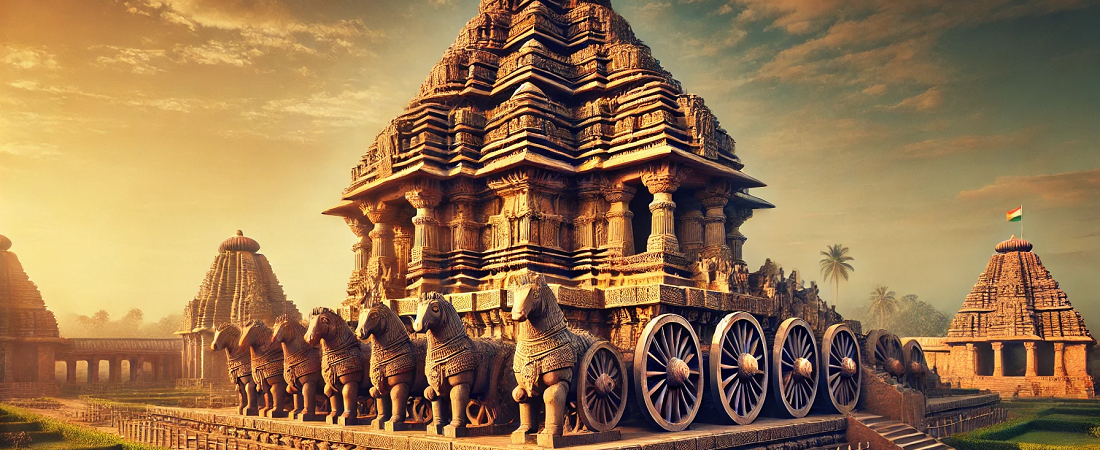The Konark Sun Temple, located in Odisha, India, is one of the most magnificent architectural marvels of India. Renowned as a UNESCO World Heritage Site, this temple stands as a testament to the architectural brilliance of ancient India. Here’s an in-depth look into its history, intricate architecture, and a complete travel guide for visiting this historic masterpiece from major Indian cities.
History of the Konark Sun Temple
The Konark Sun Temple was built in the 13th century by King Narasimhadeva I of the Eastern Ganga Dynasty. Dedicated to the Sun God (Surya), this temple represents the pinnacle of Kalinga architecture and was constructed to symbolize the chariot of the Sun God. According to historical texts, the temple once housed a magnetic lodestone that held the entire structure together, and its presence caused disruptions in ship navigation, leading to its eventual removal.
Over centuries, the temple suffered significant damage due to natural calamities and invasions. Despite this, the remaining structure continues to awe visitors with its grandeur and intricate craftsmanship.
Architectural Marvel of the Sun Temple
The Konark Sun Temple is designed as a colossal chariot with 12 intricately carved wheels and seven powerful horses, symbolizing the Sun God’s celestial journey across the sky. Key architectural highlights include:
Chariot Design: The temple resembles a massive chariot with exquisitely carved wheels, each depicting the cycle of life through the day and seasons.
Erotic Sculptures: Like the Khajuraho temples, the walls of the Konark Sun Temple are adorned with erotic sculptures, showcasing the rich artistry of the era.
Intricate Carvings: The sandstone carvings on the walls depict scenes of daily life, deities, musicians, dancers, and animals, reflecting the cultural richness of the time.
Sanctum Sanctorum (Deul): Although the main sanctum is no longer intact, the Jagamohana (audience hall) still stands tall as a magnificent structure.
The temple’s unique design makes it a fine example of Kalinga-style architecture, blending spirituality, science, and art.
How to Travel to Konark Sun Temple from Major Indian Cities
Getting to Konark is easy, thanks to well-connected transport options. Here’s how you can travel from major Indian cities:
1. From Bhubaneswar (Nearest Airport): Distance: 65 km
How to Reach: Bhubaneswar is the nearest airport. From here, you can hire a cab or take a bus to Konark. It’s a 1.5-hour scenic drive.
2. From Puri (Nearest Railway Station): Distance: 35 km
How to Reach: Puri is the closest railway station to Konark. You can take a local taxi or an Odisha Tourism bus.
3. From Delhi
Take a flight to Bhubaneswar and proceed by road.
4. From Mumbai
Board a flight to Bhubaneswar, followed by a road trip to Konark.
5. From Kolkata
You can opt for a train or flight to Bhubaneswar and drive to Konark.
6. By Road: Konark is well-connected via road. NH-316 offers a smooth drive from Puri, Bhubaneswar, and Cuttack.
Best Time to Visit Konark Sun Temple
The ideal time to visit is between October and March, as the weather is pleasant. Don’t miss the Konark Dance Festival held annually in December, showcasing classical dance forms in the backdrop of this historical site.
Tips for Visiting the Sun Temple
Wear comfortable shoes as you’ll be walking a lot.
Hire a certified guide to understand the history and significance of the carvings.
Visit the nearby Chandrabhaga Beach, known for its stunning sunrise views.
Conclusion:
The Konark Sun Temple is not just an architectural wonder but also a spiritual and cultural treasure of India. Its grandeur and historical significance make it a must-visit destination for history enthusiasts, architecture lovers, and cultural travelers. Plan your visit to experience the magic of this UNESCO World Heritage Site and dive into the rich legacy of ancient India.
